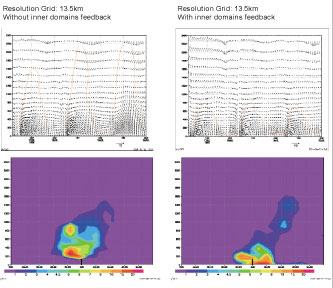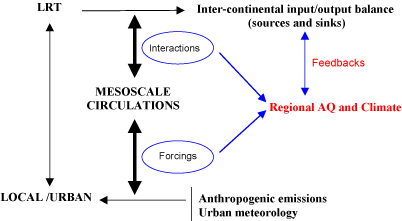
This issue in pdf Subscription Archive: Next issue: July 2005 |
|
|||||||
Meso-Meteorological Modelling for Air Pollution Applications in Mid-Latitudesby Jose-Luis Palau, Gorka Pérez-Landa and Millán M. Millán Any approach to meteorological modelling needs to take into account a variety of processes that interact synergistically at different scales (mainly in mid-latitude and complex terrain areas). Because of their potential to resolve regional and local atmospheric circulations, meso-meteorological models represent interesting tools. They are highly complex and their adaptation to a particular region requires an in-depth understanding of the limits of parameterization applicability. Over the past few years there has been a growing need to simulate meteorological fields for complex situations at finer spatial resolutions. This has been partly stimulated by scientific and technological advances (eg in dynamics, computational methods and facilities) and partly by policy pressures requiring more detailed assessments of air pollution on urban to regional scales. As a consequence, complex dynamic models have increasingly been used in Europe and the USA for meteorological and air pollution applications. Models developed for short- or long-range applications, however, are not always appropriate in flow conditions involving intermediate mesoscale features and processes (of the order of 1-1000 km). This is because parameterizations, working hypotheses and configurations need to be different for differently scaled models (as stated in the explanatory memorandum for the implementation of the European Concerted Research Action designated COST Action 728: 'Enhancing meso-scale meteorological modelling capabilities for air pollution and dispersion applications'). In this context, our group is interested in situations of complex atmospheric flows for which mesoscale models are necessary (eg sea breezes, valleys and layered flows). It is generally acknowledged that current models are far from perfect; our goal is therefore to identify the gaps in our knowledge. We are performing this research within the following European frameworks: the Cluster of European Air Quality Research (CLEAR) project FUMAPEX (integrated systems for Forecasting Urban Meteorology, Air pollution and Population EXposure); the Network of Excellence ACCENT 'Atmospheric Composition Change: A European Network'); and the 'CarboEurope-IP, Assessment of the European Terrestrial Carbon Balance'. Meteorological fields applied to air quality models (from global to local scales) may contain significant uncertainties that adversely affect simulations. There are a large number of meteorological variables needed for 'generic' air quality models, including horizontal and vertical wind components, temperature, water vapour mixing ratio, cloud fraction and liquid-water content, precipitation (rain/snow), solar actinic flux, sea-level pressure, boundary layer depth, turbulence intensity, and surface fluxes for heat, moisture and momentum. In addition to these variables, the forecasting of air quality in mid-latitudes (as in Mediterranean coastal regions) is also highly sensitive to the fact that non-local (mesoscale) effects strongly determine flows at urban scales (as reiterative experimental results have evidenced). The aforementioned atmospheric state variables are insufficient under meteorological conditions marked by non-local dynamic effects (as, for example, the compensatory subsidences over the Mediterranean coasts associated with the orographic injections resulting from the coupling of sea breezes and inland orographic upslope winds). In this sense, the meteorological models must be configured in such a way that they are able to reproduce the mesoscale dynamics at these subtropical latitudes. For instance, the interaction between different scales must be reproduced: land-use, soil moisture, sea-surface temperature, grid nesting, domain configuration, and horizontal and vertical resolution are key magnitudes/parameters in describing wind flows for air-pollution forecasting purposes and must be set up properly (see Figure 1).
In recent years, different research projects around the world have demonstrated that the pollutant 'exchange rate' between different regions and under different meteorological (and climatic) conditions is driven by interactions and forcings between different meteorological scales reaching distances of thousands of kilometres (see Figure 2).
For a believable evaluation of the impact of anthropogenic emissions from urban to global scales, one must therefore implement within numerical models all these spatial and temporal interactions, together with feedback from climate, regional air quality and transport (at local, regional and global scales). Moreover, in order to address certain issues (eg how different meteorological scales contribute to the Long-Range Transport - LRT - of regional pollution), it is necessary to resolve some scientific questions related to these meteorological interactions. In this sense, there are indications that the formation and distribution of photo-oxidants in urban plumes, at regional or continental scales, in the boundary layer and in the free troposphere, are all linked together. There are a number of EC research projects relevant to this, including MECAPIP - Meso-meteorological cycles of air pollution in the Iberian Peninsula; RECAPMA - Regional cycles of air pollution in the west central Mediterranean area; and SECAP - South European cycles of air pollution. Experimental data and complementary modelling results from these projects have established links between atmospheric circulations from local, through regional, to sub-continental scales, particularly in summer and in the central and western Mediterranean basins. Link: Please contact: |
|||||||



